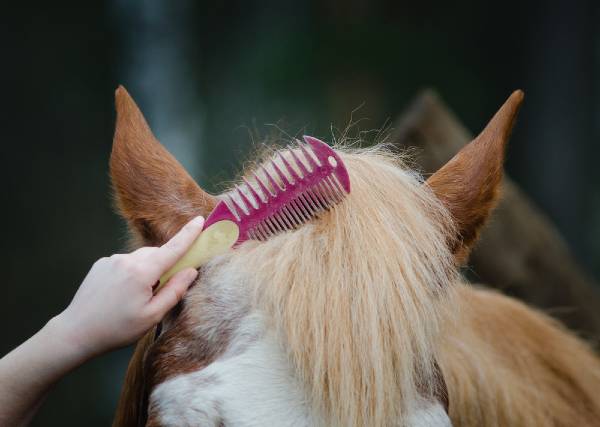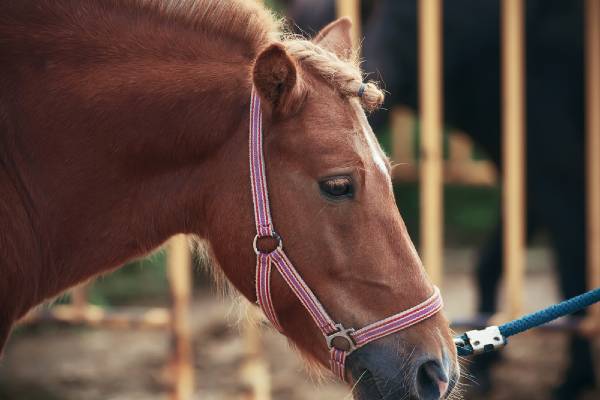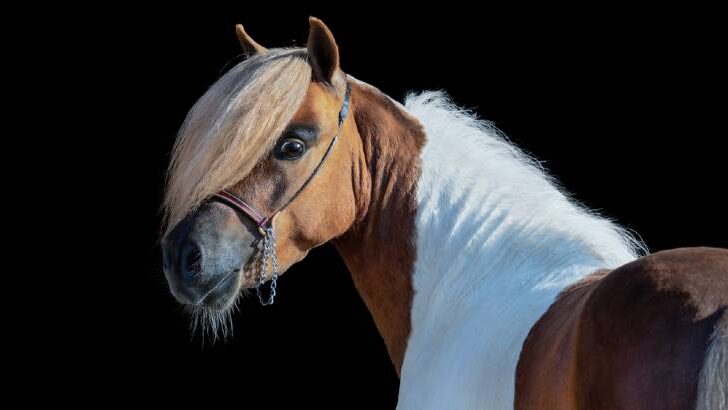Affiliate Disclaimer
As an Amazon Associate I earn from qualifying purchases. It helps me keep the website going. Thank you for your support.
Trimming the forelock is an important part of keeping your horse’s mane neat and healthy. But, what is the right way to do so? Horse owners and riders offer the following tips on how to trim a horse’s forelock:
- Never cut the forelock straight across
- Use combs to thin out the hairs if some parts of the forelock are too thick
- Use scissors or trimming shears to cut vertical cuts at a parallel angle to the forelock to make even and smooth cuts
- Leave the middle section of the forelock longer than the rest to make the natural v shape of the forelock
Even though the forelock can grow back like the rest of the mane, knowing how to trim it well keeps the mane looking clean and keeps it away from your horse’s eyes. Learn more about the forelock and mane grooming by continuing below.

What Is The Best Way to Trim a Horse’s Forelock?
Unless you are in the hunter jumper ring, where roaching the mane is a popular form of upkeep, the goal in trimming the forelock is to make it look as natural as possible.
Horse’s forelocks typically end in a point, making a v shape, the hair in the middle section is typically longer than the hair on the ends.

To achieve a natural v shape, cut vertically at an angle parallel to the forelock hair using scissors or trimming shears. Trim the end hairs slightly shorter than the hair in the middle.
Dividing the forelock into three sections will make the process more manageable and help you achieve more precision and accuracy.
If you find you need to thin out parts of the forelock, use a thinning comb to do so. Be careful not to pull too much.
If you get a few wispy or otherwise straggly hair, just comb them out of the way in the direction of the other forelock hairs
What Should You Avoid When Trimming the Forelock?
Mane-pulling is another common technique in grooming, however, pulling the forelock is not recommended because it can be painful to the horse.
A majority of horses have a much thinner forelock than the rest of the mane, so it is much more sensitive to pulling. The more sensitive an area, the more they can feel pain.
The number one least recommended forelock grooming tip is to cut it straight across with scissors. This approach makes the forelock look choppy and uneven.
The blunt edges will give the forelock a square lock, which does not match the typical v shape of the mane.

Many horse owners advise against cutting the forelock at all. It seems that almost everyone wants a thick, long forelock that can be braided to be kept away from the horse’s eyes.
If your horse has a thinning forelock, what can you do to give it some volume?
Thickening The Forelock For a Fuller Look
Some horses just have thin forelocks by nature. However, some horses thin out their forelock on their own by rubbing their head on other horses or objects.
Changing your horse’s diet can help their forelock grow thicker, Make sure to add plenty of amino acids and a biotin supplement to encourage hair growth. Skin conditions can make it difficult for the hair to grow.
Consider brushing the main daily from the roots to wake up the skin around the mane and hair follicles.
Putting your horse’s mane in braids can also help it to grow thicker.

What To Do If You Need To Thin The Forelock
If parts of the forelock need to be made thinner, take a solo comb or thinning shears and gently pull on the section you want to thin.
Pull gently so that you do not pull out more hair than you need to.
When thinning with scissors, hold them vertically and cut from the nose up to the poll. Taking small snips of hair at a time.
If you accidentally pull too much hair, the forelock will grow back. However, the rate of regrowth varies from horse to horse.
Is Pulling Or Cutting The Mane Better?
This depends on the mane and the amount of hair you are trying or style. If your horse already has a thin mane and it just needs shaping, trimming, or cutting is the better option.
If your horse has very thick hair and you need to thin it out before braiding for shows, pulling will help you achieve thinner sections faster. You can read more about the pros and cons of cutting versus pulling manes here.
General Mane Grooming Tips
The forelock is just one part of the whole mane. A healthy mane is part of good grooming. Here are some tips to help you with mane upkeep.
When washing and shampooing the mane, be very thorough and scrub the shampoo into the roots, massaging it in. Wash the underside of the mane, making sure to scrub out all the dirt.
Rinse all the product out of the hair to prevent residue from building up. Apply a light layer of conditioner and put some water in it to help it lather.
Rinse out the conditioner well to prevent it from making the hair oily. Adding a leave-in conditioner after washing helps bring the oils back.
Mane hair is much like human hair. Avoid sulfate-heavy shampoo because it strips all the natural oils away. Choose products with ingredients that add moisture to the hair.
There are many different grooming shampoos, so choose the ones that fit your needs and goals.
Use your fingers to untangle knots and prevent the hair from breaking. Always brush the main from the bottom and go up to the roots.
Take your time when grooming to avoid making mistakes.
Some people roach or shave the mane fully off to allow it to grow back healthier if it is too matted. Sometimes roaching is done because the owner likes the way it looks.
Roaching can help define a muscled horse’s features.
How To Trim a Horse’s Forelock – Conclusion
There are a few ways to trim a horse’s forelock and make it look healthy and natural. You can either use scissors or trimming shears. You can also pull the forelock hair if you prefer. However you choose to groom it, remember that it will grow back and you can always try different methods until you find the best one for your horse.
References:




